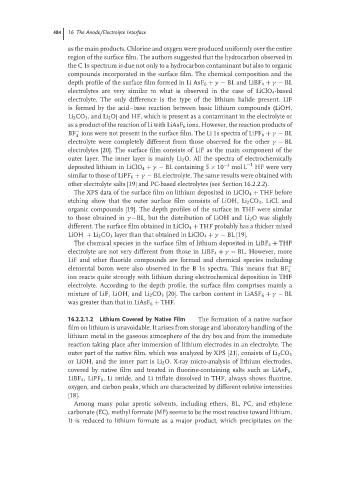Page 511 - Handbook of Battery Materials
P. 511
484 16 The Anode/Electrolyte Interface
as the main products. Chlorine and oxygen were produced uniformly over the entire
region of the surface film. The authors suggested that the hydrocarbon observed in
the C 1s spectrum is due not only to a hydrocarbon contaminant but also to organic
compounds incorporated in the surface film. The chemical composition and the
depth profile of the surface film formed in Li AsF 6 + γ − BL and LiBF 4 + γ − BL
electrolytes are very similar to what is observed in the case of LiClO 4 -based
electrolyte. The only difference is the type of the lithium halide present. LiF
is formed by the acid–base reaction between basic lithium compounds (LiOH,
Li 2 CO 3 , and Li 2 O) and HF, which is present as a contaminant in the electrolyte or
as a product of the reaction of Li with LiAsF 6 ions. However, the reaction products of
−
BF ions were not present in the surface film. The Li 1s spectra of LiPF 6 + γ − BL
4
electrolyte were completely different from those observed for the other γ − BL
electrolytes [20]. The surface film consists of LiF as the main component of the
outer layer. The inner layer is mainly Li 2 O. All the spectra of electrochemically
deposited lithium in LiClO 4 + γ − BL containing 5 × 10 −3 mol L −1 HF were very
similar to those of LiPF 6 + γ − BL electrolyte. The same results were obtained with
other electrolyte salts [19] and PC-based electrolytes (see Section 16.2.2.2).
The XPS data of the surface film on lithium deposited in LiClO 4 + THF before
etching show that the outer surface film consists of LiOH, Li 2 CO 3 , LiCl, and
organic compounds [19]. The depth profiles of the surface in THF were similar
to those obtained in γ −BL, but the distribution of LiOH and Li 2 O was slightly
different. The surface film obtained in LiClO 4 + THF probably has a thicker mixed
LiOH + Li 2 CO 3 layer than that obtained in LiClO 4 + γ − BL [19].
The chemical species in the surface film of lithium deposited in LiBF 4 + THF
electrolyte are not very different from those in LiBF 4 + γ − BL. However, more
LiF and other fluoride compounds are formed and chemical species including
elemental boron were also observed in the B 1s spectra. This means that BF −
4
ion reacts quite strongly with lithium during electrochemical deposition in THF
electrolyte. According to the depth profile, the surface film comprises mainly a
mixture of LiF, LiOH, and Li 2 CO 3 [20]. The carbon content in LiASF 6 + γ − BL
was greater than that in LiAsF 6 + THF.
16.2.2.1.2 Lithium Covered by Native Film The formation of a native surface
film on lithium is unavoidable. It arises from storage and laboratory handling of the
lithium metal in the gaseous atmosphere of the dry box and from the immediate
reaction taking place after immersion of lithium electrodes in an electrolyte. The
outer part of the native film, which was analyzed by XPS [21], consists of Li 2 CO 3
or LiOH, and the inner part is Li 2 O. X-ray micro-analysis of lithium electrodes,
covered by native film and treated in fluorine-containing salts such as LiAsF 6 ,
LiBF 4 ,LiPF 6 , Li imide, and Li triflate dissolved in THF, always shows fluorine,
oxygen, and carbon peaks, which are characterized by different relative intensities
[18].
Among many polar aprotic solvents, including ethers, BL, PC, and ethylene
carbonate (EC), methyl formate (MF) seems to be the most reactive toward lithium.
It is reduced to lithium formate as a major product, which precipitates on the

